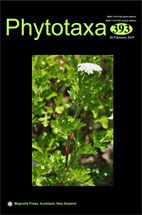Abstract
Lactarius sect. Deliciosi is a group of ectomycorrhizal mushrooms showing high host specificity with trees of Pinaceae and more rarely Fagales. A new species of this section, L. guangdongensis, is described from South China. This new species has the smallest basidiocarps (pileus 1–3 cm) in the section. The pure orange basidiocarps with faint greenish discoloration are similar to those of Abies-associated L. abieticola and L. laeticolor and Pinus-associated L. vividus. The subdistant lamellae and absence of pleuromacrocystidia can be used as valid characters for this species. It grows with Chinese national protected plant Pinus kwangtungensis and might be one of the very few species that form symbiosis with five-needle pines. Phylogenetic analyses of the ITS region and glyceraldehyde-3-phosphate dehydrogenase gene (gpd) show that L. guangdongensis clearly diversified from its relatives and look-alikes and probably represents an early diverging lineage in the section. Molecular and morphological characters provided in this study will be useful for in situ and ex situ conservation of P. kwangtungensis in the future.

